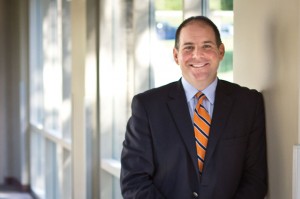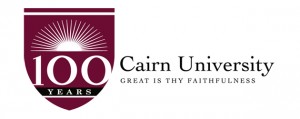 [dropcap3]S[/dropcap3]ome years ago in a University Update meeting, I shared a quote from President Abraham Lincoln. We were beginning to outline the series of changes that were envisioned to move the University forward and position it for its second century as a regional university committed to the centrality of Christ and Scripture. Lincoln, in his well-known “house divided” speech to the Republican State Convention in Springfield, Illinois, in June of 1858, began by stating that we must determine “where we are and whither we are tending.” I have always been fond of this line, drawing from it often to remind me that determining what to do next means honestly assessing the current state of things. Change should not be undertaken for change’s sake. And we should never blindly plow forward without knowing the current assets and liabilities, as well as present challenges and opportunities, that make up our immediate context. Neither can we hold a current position simply to preserve the past or the present. As we enter into the year of celebrating our Centennial, I am looking through a considerable amount of documents, records, and histories. In walking through the past, I am confident that those who went before us often applied that same wisdom Lincoln called for. So many of the changes in the school’s history came at critical junctures and moved the institution forward in significant ways. God’s sovereign hand of provision and His great faithfulness are evident in the hundred years of change and development that make up our story, which is why we chose the theme for the Centennial. For nearly one hundred years, through two World Wars, a Depression, the Cold War, a cultural revolution, an economic and energy crisis, the rise of evangelical prominence and influence, and decades of societal movement resulting in the marginalization of the Bible and a path toward post-Christian culture, the school has both steadfastly endured and strategically changed, by God’s grace. As we look to celebrate a century of work and service, we also want to look to the day at hand and forward to the future.
[dropcap3]S[/dropcap3]ome years ago in a University Update meeting, I shared a quote from President Abraham Lincoln. We were beginning to outline the series of changes that were envisioned to move the University forward and position it for its second century as a regional university committed to the centrality of Christ and Scripture. Lincoln, in his well-known “house divided” speech to the Republican State Convention in Springfield, Illinois, in June of 1858, began by stating that we must determine “where we are and whither we are tending.” I have always been fond of this line, drawing from it often to remind me that determining what to do next means honestly assessing the current state of things. Change should not be undertaken for change’s sake. And we should never blindly plow forward without knowing the current assets and liabilities, as well as present challenges and opportunities, that make up our immediate context. Neither can we hold a current position simply to preserve the past or the present. As we enter into the year of celebrating our Centennial, I am looking through a considerable amount of documents, records, and histories. In walking through the past, I am confident that those who went before us often applied that same wisdom Lincoln called for. So many of the changes in the school’s history came at critical junctures and moved the institution forward in significant ways. God’s sovereign hand of provision and His great faithfulness are evident in the hundred years of change and development that make up our story, which is why we chose the theme for the Centennial. For nearly one hundred years, through two World Wars, a Depression, the Cold War, a cultural revolution, an economic and energy crisis, the rise of evangelical prominence and influence, and decades of societal movement resulting in the marginalization of the Bible and a path toward post-Christian culture, the school has both steadfastly endured and strategically changed, by God’s grace. As we look to celebrate a century of work and service, we also want to look to the day at hand and forward to the future.
 In our last issue of Cairn magazine, we introduced the Centennial theme of “Great is Thy Faithfulness.” We also shared the special commemorative logo we will be using this next year. That logo reflects our official university logo in that it is comprised of a shield, representing the shield of faith in Ephesians 6. It bears the number 100 to memorialize the century mark. And atop that number is an image of the sun on the horizon.
In our last issue of Cairn magazine, we introduced the Centennial theme of “Great is Thy Faithfulness.” We also shared the special commemorative logo we will be using this next year. That logo reflects our official university logo in that it is comprised of a shield, representing the shield of faith in Ephesians 6. It bears the number 100 to memorialize the century mark. And atop that number is an image of the sun on the horizon.
When that design was brought to me for review, the first thing I thought of was the story from American history of Benjamin Franklin’s comments at the signing of the Constitution in 1787. After lengthy debate and the completion of the Constitution, many delegates were still not pleased with the document, and some refused to sign. Franklin, in his eighties, watched the entire drama, uncertain of the outcome. As the representatives signed the Constitution, the president’s chair was at the front of the hall, and a sun was painted on the back of the chair. Franklin told some of the members near him that it was always difficult for painters to show the difference between the rising sun and the setting sun. He said that during the convention he had often looked at the painted sun and wondered “whether it was rising or setting. But now at length, I have the happiness to know that it is a rising and not a setting sun.” This is often the way with change and the future. It is especially so when we love and cherish our past. Franklin’s comments about the sun on the back of President Washington’s chair resonate with us. We understand innately what he means and what he was thinking. In our humanity, we cannot see the future. We cannot know for certain whether the best is behind us or before us. It is not merely an issue of whether we are optimists or pessimists. We are human. When we look at a photo of a sunrise or sunset without knowing whether the camera faces east or west, we can only guess if the image is a rising or setting sun. I can imagine that as Franklin and the other founders listened to the debates about the future of the nation, the challenges that it would face, and the changes that a strong federal government would bring to individual states, many were wondering if all that had transpired in the past would be squandered. In my mind’s eye, I can see the looks of concern and frustration on their faces. However, at the close of the sessions, progress was made, not with consensus or unanimity, but nonetheless, the country moved forward, and the land had a new law that bound them together and determined what kind of a nation this would be. At this moment, it became clear to the aged Franklin that this sun was a rising one, and in his long years, he still found the energy to look forward and not backward.
We are celebrating one hundred years, and we will do so with great joy. We will remember the accomplishments of the past and rejoice in God’s gracious provision and preservation. We will recall with great fondness the memories of old friends, former campuses, and iconic figures from our history.
We are celebrating one hundred years, and we will do so with great joy. We will remember the accomplishments of the past and rejoice in God’s gracious provision and preservation. We will recall with great fondness the memories of old friends, former campuses, and iconic figures from our history. But we must not see this sun as setting. The sun is rising. It is always so for Christians. Not because we say it is so, but because we serve Eternal God, who is the same yesterday, today, and forever, though this world and how we live in it is not. The sun is rising, not because we deserve it to be, but because we serve the Sovereign God who brought us this far and has enabled us to do what we are presently doing. And finally, the sun is rising, not because we hope it will be, but because we serve Almighty God who orders the world and accomplishes His divine purposes. He calls us to press forward to the very end, hopeful, to the last ounce of our strength, until the final trumpet sounds.
This Centennial is cause to celebrate the past, live in the present, and look to the future. I trust that this issue of the magazine will help you do just that.
[framed_box]Todd J. Williams, Ph.D., has been the President of Cairn University since January 2008. He served as faculty and an administrator from 1996 to 2001, and then returned as Provost in 2005. He can be reached by emailing president@cairn.edu.
[/framed_box]